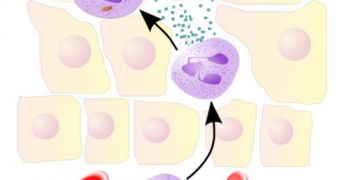A team of scientists at the University of Colorado in Boulder (UCB) believes it may have set the foundations for a new approach in investigating human inflammatory diseases. In a new study the group conducted on unsuspecting lab mice, they discovered that rodents infected with the known bacteria salmonella exhibit a host of symptoms that are very similar to the ones that humans exhibit when they suffer from Hemophagocytic Lymphohistiocytosis (HLH). This rare disorder kills between 50 and 90 percent of all the individuals it infects, and so discovering a new way of studying it could save many lives, PhysOrg reports.
The condition is unfortunately very little understood at this point, but the UCB team argues that their new results could be used as a stepping stone for a host of new therapies to address it. The disease can be passed down from mother to children, a form known as primary HLH, or can be acquired by individuals with no history of genetic malformations. In this case, it is called secondary HLH. The only known courses of treatment for this type of infection involve bone marrow transplant, a medical procedure that has life-long side-effects, and is also not guaranteed to succeed. The researchers say that both forms develop when infections occur, and they both hyperactivate the immune system.
Additionally, primary HLH unfortunately affects young children and infants very often, in most cases with lethal consequences. Knowing this, experts say that the new investigation provides a breath of fresh air into a field of research where progress has been slow for years. Details of the work appear in the February 26 issue of the Public Library of Science's open-access journal PLoS One. The lead author of the investigation is Diane Brown, the adjoint curator of the Museum of Natural History at UCB. Coauthors include a number of experts from the university's Molecular, Cellular and Developmental Biology Department. The study was funded with money secured from the US National Institutes of Health (NIH), through the American Recovery and Relief Act (ARRA).
“One part of this study is to try to use our research to understand how anemia develops in these infected mice, which might help us understand how symptoms of HLH develop. The availability of this animal model for HLH will help to advance the research and understanding of the underlying mechanisms of this immune system disorder. It also should provide a means to test new therapies for HLH,” concludes UCB assistant professor Corrella Detweiler, who was also a part of the study.

 14 DAY TRIAL //
14 DAY TRIAL //